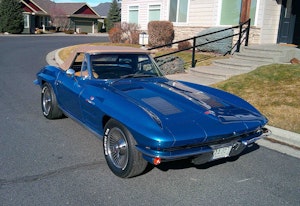Media | Articles
Tech Tips by the Dozen VIII
Stabilizer links for many old cars are available as close as your local auto parts store and cost less than $15 per pair. Remove old ones by chiseling open the seam on the spacer, and then apply force with a wrench to snap off the (usually) frozen nuts.
When bending fuel line for old cars, it’s best to start with 25- or 50-ft. coils (available in auto parts stores) if you want an original look. Bend the lines to the correct shape and cut them to the proper size using original lines as a pattern. Double flare any flared ends.
Blow out the lid of any can containing auto paint with compressed air. Use a long-nosed nozzle and gently blow away dust, dirt and any other foreign matter. This will eliminate sources of possible paint contamination.
When torquing old castle nuts, you may need to file/grind the bottom surface to make the “turrets” line up with the cotter pin. It’s best to pre-torque these nuts and get the values right. After you file/grind, deburr the surface to remove grinding residue and chips.
Always use a good assembly lubricant when putting hydraulic components that run in hydraulic fluid back together. Do not use brake fluid for this, since it is hydroscopic, which means it absorbs water. That can cause rusting later on.
Marketplace
Buy and sell classics with confidence
When bending brake lines, getting the curves just right is essential for a correct restoration. This will be easier to do if you hold the original line gently in a vise as you bend the new line to the same contours.
Stuck brake drums are a common problem on old cars that sat for years. When using a tool to free the drums, you’ll usually have better luck rotating them backwards, rather than forwards because primary brake shoes are designed to counteract forward rotation.
Along the same lines, stuck brake drums can sometimes be removed with a long bar and brackets fastened across the bolts. Use the lug nuts to fasten the brackets to the bolts and rotate the drum backwards with the bar. Dirt will likely fall out.
If your lug nuts are stuck, try this: Put a short 6-point socket on a half-inch breaker bar. Slide a 3-ft. to 4-ft. piece of pipe over the breaker bar and as close to the socket as possible. With someone holding the brake pedal down, use the bar to free up lug nuts.
Springs used between the accelerator pedal and carburetor linkage on early-1950s Ford and IH trucks had a habit of breaking.. If you’re touring and this happens, you can substitute an air hose for the spring as a temporary fix.
To time a car on the road, take high-tension coil lead and hold it about 3/8-inch from the engine block with the ignition switch on. When the points break contact, a spark will jump. If the timing marks are lined up as this happens, the timing is set pretty close.
If your car is stalling, bucking and backfiring, your breaker point gap may have closed up. Check by watching a timing light as the car runs. If you see very weak flashes of light, recheck your point gap. With a proper gap setting the light flashes are stronger.
John “Gunner” Gunnell is the automotive books editor at Krause Publications in Iola, Wis., and former editor of Old Cars Weekly and Old Cars Price Guide.










